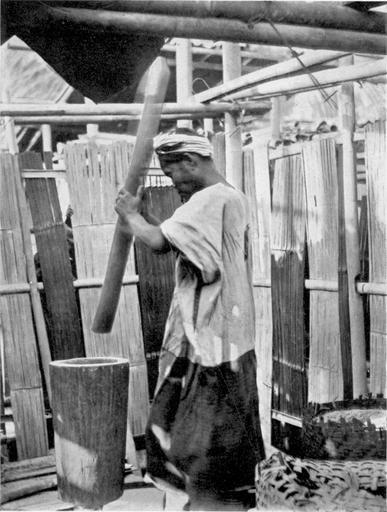MAKE A MEME
View Large Image

| View Original: | In_the_remoter_hill_districts.jpg (2105x2783) | |||
| Download: | Original | Medium | Small | Thumb |
| Courtesy of: | www.flickr.com | More Like This | ||
| Keywords: harry ignatius marshall harryignatiusmarshall black and white blackandwhite karen photo blackandwhite monochrome black and white In the remoter hill districts yet untouched by the influences of western civilization, which are sweeping over the plains, the Karens still follow the primitive method of burning off a plot of forest each year, on which to raise their regular supply of paddy-rice. Often the village site is also shifted from year to year. Threading the jungle-paths in these lonely hills, one suddenly emerges upon a stockade surrounding a village perched on the side of a high bank, at the foot of which flows a stream of clear, cool water. A slender ladder leads to the village-house, which shelters some twenty families. It is made entirely of bamboo, and from post to roof no nail or board or plank is used, the split bamboo floor resting upon round joists and girders secured by bamboo-fiber withes. This community dwelling is built on a very simple plan, consisting of a "blaw" or guest-room and a long corridor with many rooms on each side. Weddings, funerals and feasts, as well as the more usual events of daily life, make the building hum with activity. Work in the fields takes the Karens away from the village, but when the crop has been harvested, the paddy is brought back to the village-house, where the husks must be pounded off with a bamboo pestle before the rice is ready for use. The mortar consists of a log about ten feet long, set up like a post in the ground, so that the upper part, hollowed out to receive the grain, protrudes above the elevated floor of the village-house. In the remoter hill districts yet untouched by the influences of western civilization, which are sweeping over the plains, the Karens still follow the primitive method of burning off a plot of forest each year, on which to raise their regular supply of paddy-rice. Often the village site is also shifted from year to year. Threading the jungle-paths in these lonely hills, one suddenly emerges upon a stockade surrounding a village perched on the side of a high bank, at the foot of which flows a stream of clear, cool water. A slender ladder leads to the village-house, which shelters some twenty families. It is made entirely of bamboo, and from post to roof no nail or board or plank is used, the split bamboo floor resting upon round joists and girders secured by bamboo-fiber withes. This community dwelling is built on a very simple plan, consisting of a "blaw" or guest-room and a long corridor with many rooms on each side. Weddings, funerals and feasts, as well as the more usual events of daily life, make the building hum with activity. Work in the fields takes the Karens away from the village, but when the crop has been harvested, the paddy is brought back to the village-house, where the husks must be pounded off with a bamboo pestle before the rice is ready for use. The mortar consists of a log about ten feet long, set up like a post in the ground, so that the upper part, hollowed out to receive the grain, protrudes above the elevated floor of the village-house. | ||||